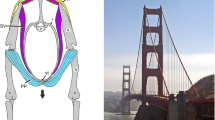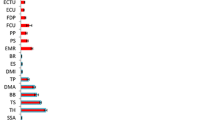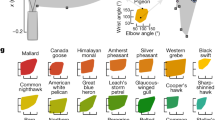Abstract
The avian wing possesses the ability to synchronize flexion or extension of the elbow and wrist joints automatically. Skeletal and muscular mechanisms are involved in generating this phenomenon. The “drawing-parallels” action of the radius and ulna coordinates the movements of the forearm with the carpus. Movement of the radius along the length of the forearm isnot dependent on the shape disparity between the dorsal and ventral condyles of the humerus, nor is it generated by the shape of the dorsal condyle itself. Instead, shifting of the radius toward the wrist occurs during humeroulnar flexion when the radius, being pushed by muscles toward the ulna, is deflected off theIncisura radialis toward the wrist. Movement of the radius toward the elbow occurs during the latter stages of humeroulnar extension when, as the dorsal condyle of the humerus and the articular surface of the ulna's dorsal cup roll apart, the radius gets pulled by the humerus and its ligaments away from the wrist. Synchronization of the forearm with the manus is accomplished by twojoint muscles and tendons.M. extensor metacarpi radialis and the propatagial tendons act to extend the manus in unison with the forearm, whileM. extensor metacarpi ulnaris helps these limb segments flex simultaneously.M. flexor carpi ulnaris, in collaboration with the “drawing-parallels” mechanisms, flexes the carpus automatically when the elbow is flexed, thereby circumducting the manus from the plane of the wing toward the body. In a living bird, these skeletal and muscular coordinating mechanisms may function to automate the internal kinematics of the wing during flapping flight. A mechanized wing may also greatly facilitate the initial flight of fledgling birds. The coordinating mechanisms of the wing can be detected in a bird's osteology, thereby providing researchers with a new avenue by which to gauge the flight capabilities of avian fossil taxa.
Similar content being viewed by others
References
Alix E (1874) L'Appareil Locomoteur des Oiseaux, Paris
Baumel JJ, King AS, Lucas AM, Breazile JE, Evans HE (eds) (1979) Nomina Anatomica Avium. Academic Press, London
Bentz GD, Zusi RL (1982) The humeroulnar pulley and its evolution in hummingbirds. Wilson Bull 94:71–73
Berger AJ (1956) On the anatomy of the red bird of paradise with comparative remarks on the Corvidae. Auk 73:427–446
Berger AJ (1968) Appendicular myology of Kirtland's warbler. Auk 85:594–616
Bergmann C (1839) ber die Bewegungen von Radius und Ulna am Vogelflgel. Mllers Arch F Anat Physiol, pp 296–300
Bock WJ (1965) Experimental analysis of the avian passive perching mechanism. Am Zool 5:681
Coues E (1871) On the mechanism of flexion and extension in birds' wings. Proc Am Assoc Advance Sci 20:278–284
Dial KP (1992) Activity patterns of the wing muscles of the pigeon (Columba livia) during different modes of flight. J Exp Zool 262:357–373
Dial KP, Goslow GE Jr, Jenkins FA Jr (1991) The functional anatomy of the shoulder in the European starling (Sturnus vulgaris). J Morphol 207:327–344
Fisher HI (1946) Adaptations and comparative anatomy of the locomotor apparatus of New World vultures. Am Midl Nat 35:545–727
Fisher HI (1957) Bony mechanism of automatic flexion and extension in the pigeon's wing. Science 126:446
Garrod AH (1875) On a point in the mechanism of the bird's wing. Proc Zool Soc Lond, pp 82–84
George JC, Berger AJ (1966) Avian Myology. Academic Press, New York
Grohmann J (1939) Modifikation oder Funktionsreifung? Z Tierpsychol 2:132–144
Hudson GE, Lanzillotti PJ (1955) Gross anatomy of the wing muscles in the family Corvidae. Am Midl Nat 53:1–44
Jenkins FA Jr, Dial KP, Goslow Jr (1988) A cineradiographic analysis of bird flight: the wishbone in starlings is a spring. Science 241:1495–1498
Marsh OC (1880) Odontornithes: a monograph on the extinct toothed birds of North America. Report of the U.S. Geological Exploration of the Fortieth parallel, No. 7, Washington D.C.
Mckitrick MC (1991) Forelimb myology of loons (Gaviiformes) with comments on the relationship of loons and tubenoses (Procellariiformes). Zool J Linn Soc 102:115–152
Norberg UM (1990) Vertebrate flight. Zoophysiology 27:209–211
Ostrom JH (1976) Some hypothetical anatomical stages in the evolution of avian flight. Smithon Contrib Paleobiol 27:1–21
Peters DS (1984) Konstruktionsmorphologische Gesichtspunkte zur Entstehung der Vgel. Nat Mus 114:199–210
Peters DS (1985) Functional and constructive limitations in the early evolution of birds. In: Hecht MK et al. (eds) The beginnings of birds. Freunde des Jura-Museums Eichsttt, Eichsttt, pp 243–248
Raikow RJ (1985) Locomotor system. In: King AS, MacLelland J (eds) Form and function in birds, vol 3. Academic Press, London
Shufeldt RW (1890) The myology of the raven. Macmillan, New York, p 142
Skutch AF (1976) Parent birds and their young, University of Texas, Austin, pp 293–297
Spring L (1971) A comparison of functional and morphological adaptations in the common murre (Uria aalge) and thick-billed murre (Uria lomvia). Condor 73:1–27
Sy M (1936) Funktionell-anatomische Untersuchungen am Vogelflgel. J Ornothol 84:199–296
Thilo P (1915) Die Luftscke der Vgel als Sperrvorrichtungen. Korrbl Naturf-Riga 57:139–157
Vanden Berge JC (1970) A comparative study of the appendicular musculature of the order Ciconiiformes. Am Midl Nat 84:289–364
Vazquez RJ (1992) Functional osteology of the avian wrist and the evolution of flapping flight. J Morphol 211:259–268
Author information
Authors and Affiliations
Rights and permissions
About this article
Cite this article
Vazquez, R.J. The automating skeletal and muscular mechanisms of the avian wing (Aves). Zoomorphology 114, 59–71 (1994). https://doi.org/10.1007/BF00574915
Received:
Issue Date:
DOI: https://doi.org/10.1007/BF00574915




